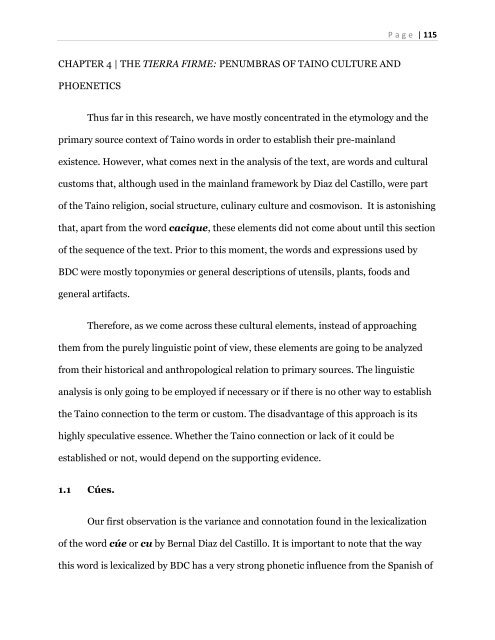Language of the Voiceless: Traces of Taino Language, Food, and Culture in the Americas From 1492 to the Present
by Leonardo Nin
by Leonardo Nin
Create successful ePaper yourself
Turn your PDF publications into a flip-book with our unique Google optimized e-Paper software.
P a g e | 115<br />
CHAPTER 4 | THE TIERRA FIRME: PENUMBRAS OF TAINO CULTURE AND<br />
PHOENETICS<br />
Thus far <strong>in</strong> this research, we have mostly concentrated <strong>in</strong> <strong>the</strong> etymology <strong>and</strong> <strong>the</strong><br />
primary source context <strong>of</strong> <strong>Ta<strong>in</strong>o</strong> words <strong>in</strong> order <strong>to</strong> establish <strong>the</strong>ir pre-ma<strong>in</strong>l<strong>and</strong><br />
existence. However, what comes next <strong>in</strong> <strong>the</strong> analysis <strong>of</strong> <strong>the</strong> text, are words <strong>and</strong> cultural<br />
cus<strong>to</strong>ms that, although used <strong>in</strong> <strong>the</strong> ma<strong>in</strong>l<strong>and</strong> framework by Diaz del Castillo, were part<br />
<strong>of</strong> <strong>the</strong> <strong>Ta<strong>in</strong>o</strong> religion, social structure, cul<strong>in</strong>ary culture <strong>and</strong> cosmovison. It is as<strong>to</strong>nish<strong>in</strong>g<br />
that, apart from <strong>the</strong> word cacique, <strong>the</strong>se elements did not come about until this section<br />
<strong>of</strong> <strong>the</strong> sequence <strong>of</strong> <strong>the</strong> text. Prior <strong>to</strong> this moment, <strong>the</strong> words <strong>and</strong> expressions used by<br />
BDC were mostly <strong>to</strong>ponymies or general descriptions <strong>of</strong> utensils, plants, foods <strong>and</strong><br />
general artifacts.<br />
Therefore, as we come across <strong>the</strong>se cultural elements, <strong>in</strong>stead <strong>of</strong> approach<strong>in</strong>g<br />
<strong>the</strong>m from <strong>the</strong> purely l<strong>in</strong>guistic po<strong>in</strong>t <strong>of</strong> view, <strong>the</strong>se elements are go<strong>in</strong>g <strong>to</strong> be analyzed<br />
from <strong>the</strong>ir his<strong>to</strong>rical <strong>and</strong> anthropological relation <strong>to</strong> primary sources. The l<strong>in</strong>guistic<br />
analysis is only go<strong>in</strong>g <strong>to</strong> be employed if necessary or if <strong>the</strong>re is no o<strong>the</strong>r way <strong>to</strong> establish<br />
<strong>the</strong> <strong>Ta<strong>in</strong>o</strong> connection <strong>to</strong> <strong>the</strong> term or cus<strong>to</strong>m. The disadvantage <strong>of</strong> this approach is its<br />
highly speculative essence. Whe<strong>the</strong>r <strong>the</strong> <strong>Ta<strong>in</strong>o</strong> connection or lack <strong>of</strong> it could be<br />
established or not, would depend on <strong>the</strong> support<strong>in</strong>g evidence.<br />
1.1 Cúes.<br />
Our first observation is <strong>the</strong> variance <strong>and</strong> connotation found <strong>in</strong> <strong>the</strong> lexicalization<br />
<strong>of</strong> <strong>the</strong> word cúe or cu by Bernal Diaz del Castillo. It is important <strong>to</strong> note that <strong>the</strong> way<br />
this word is lexicalized by BDC has a very strong phonetic <strong>in</strong>fluence from <strong>the</strong> Spanish <strong>of</strong>


















